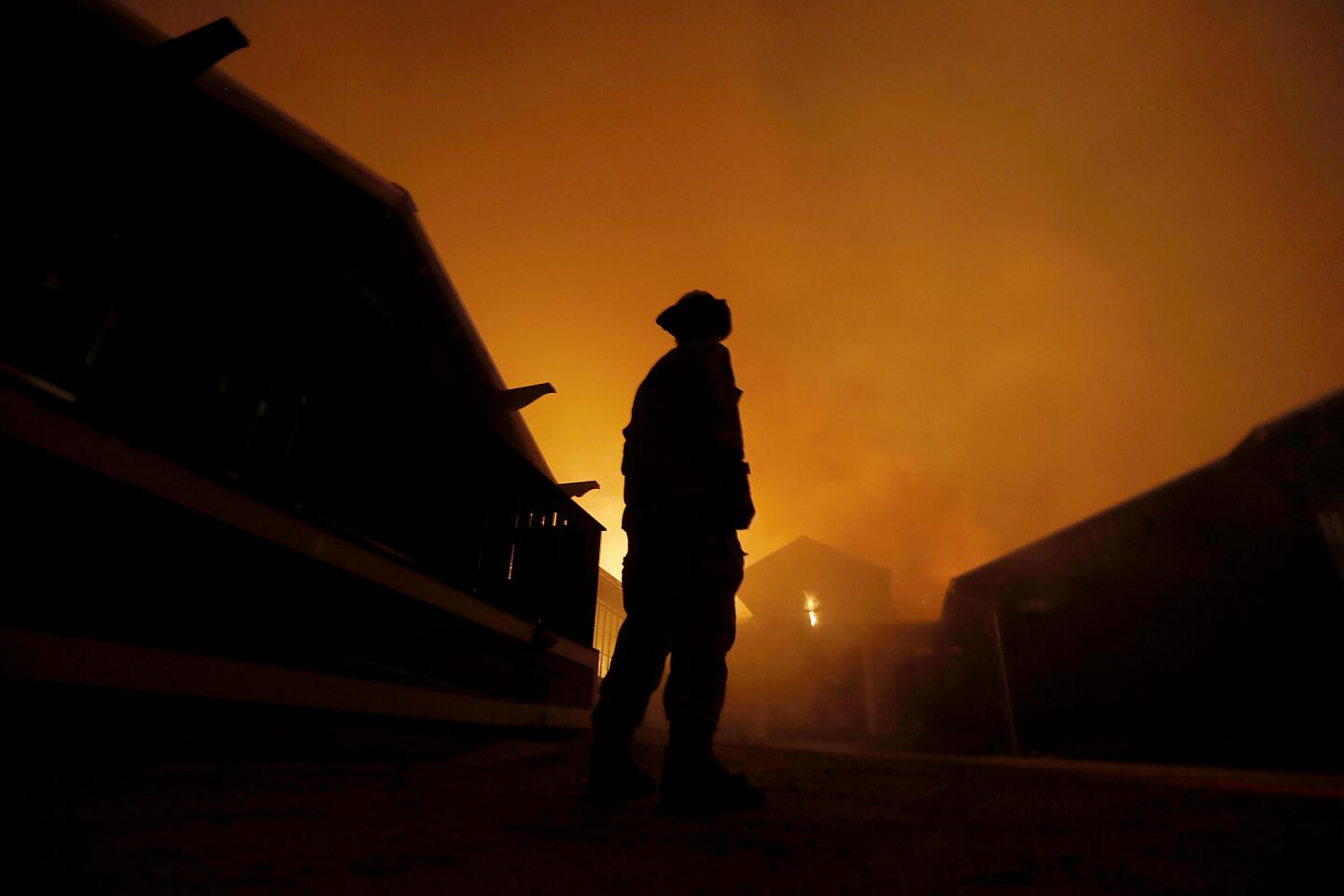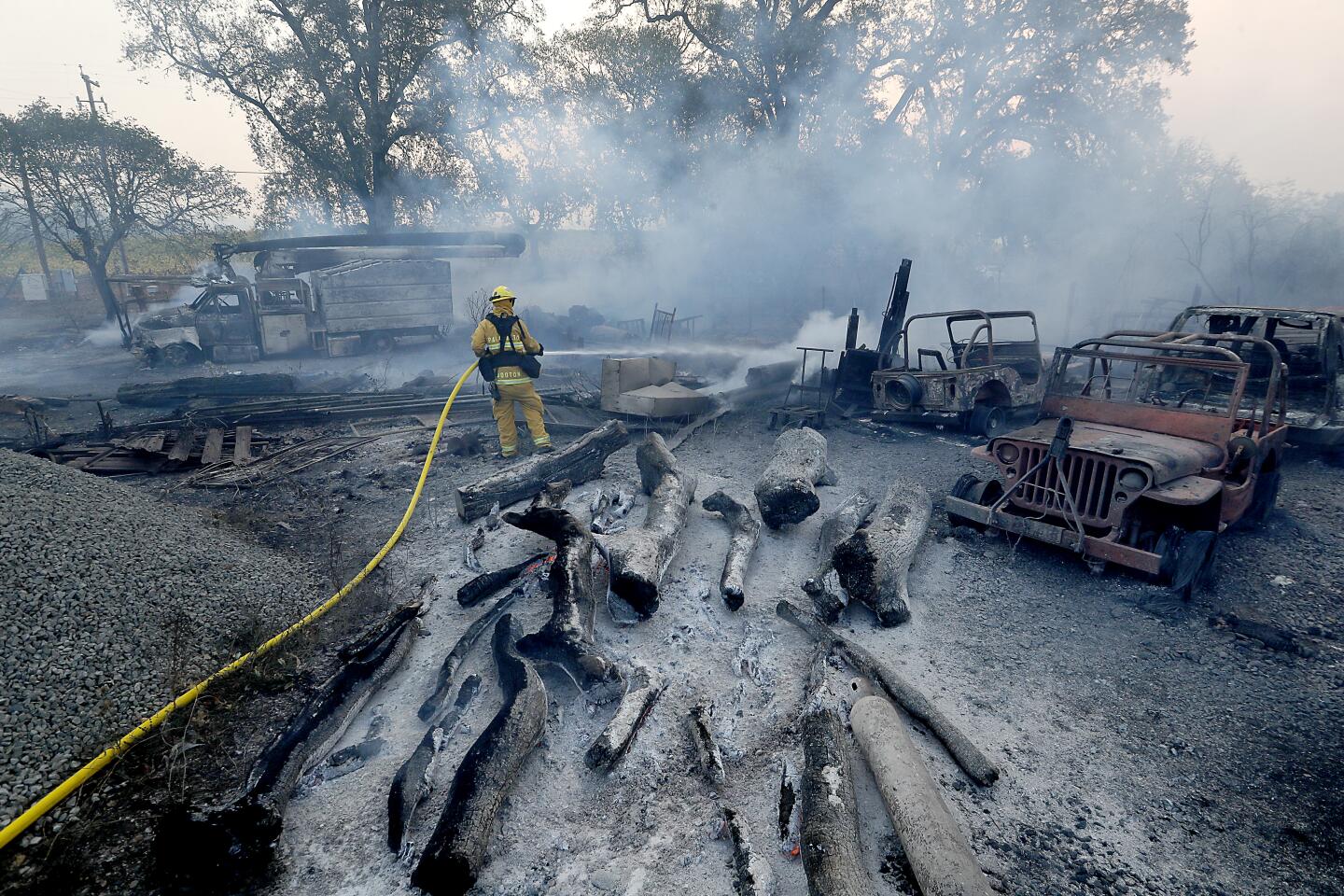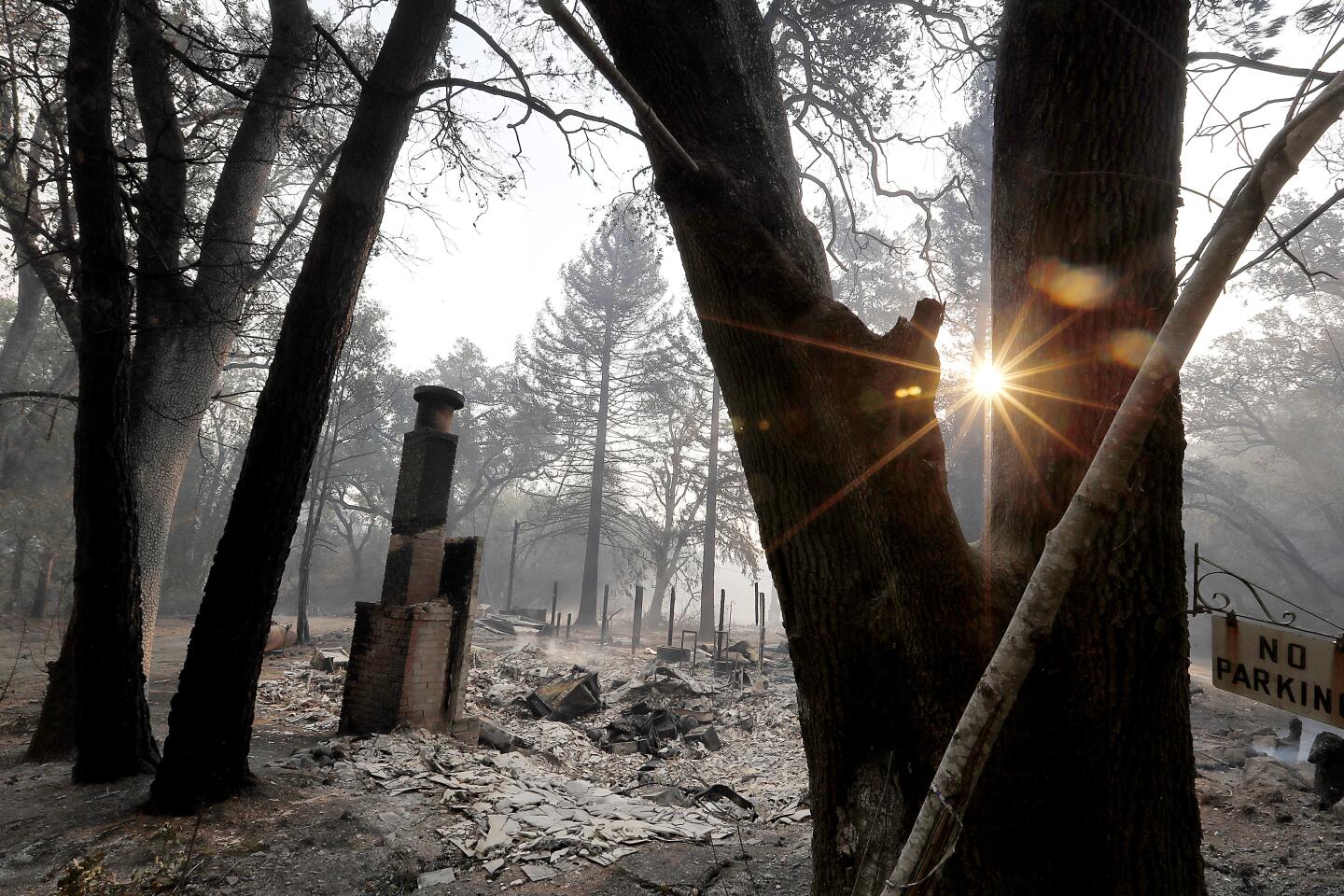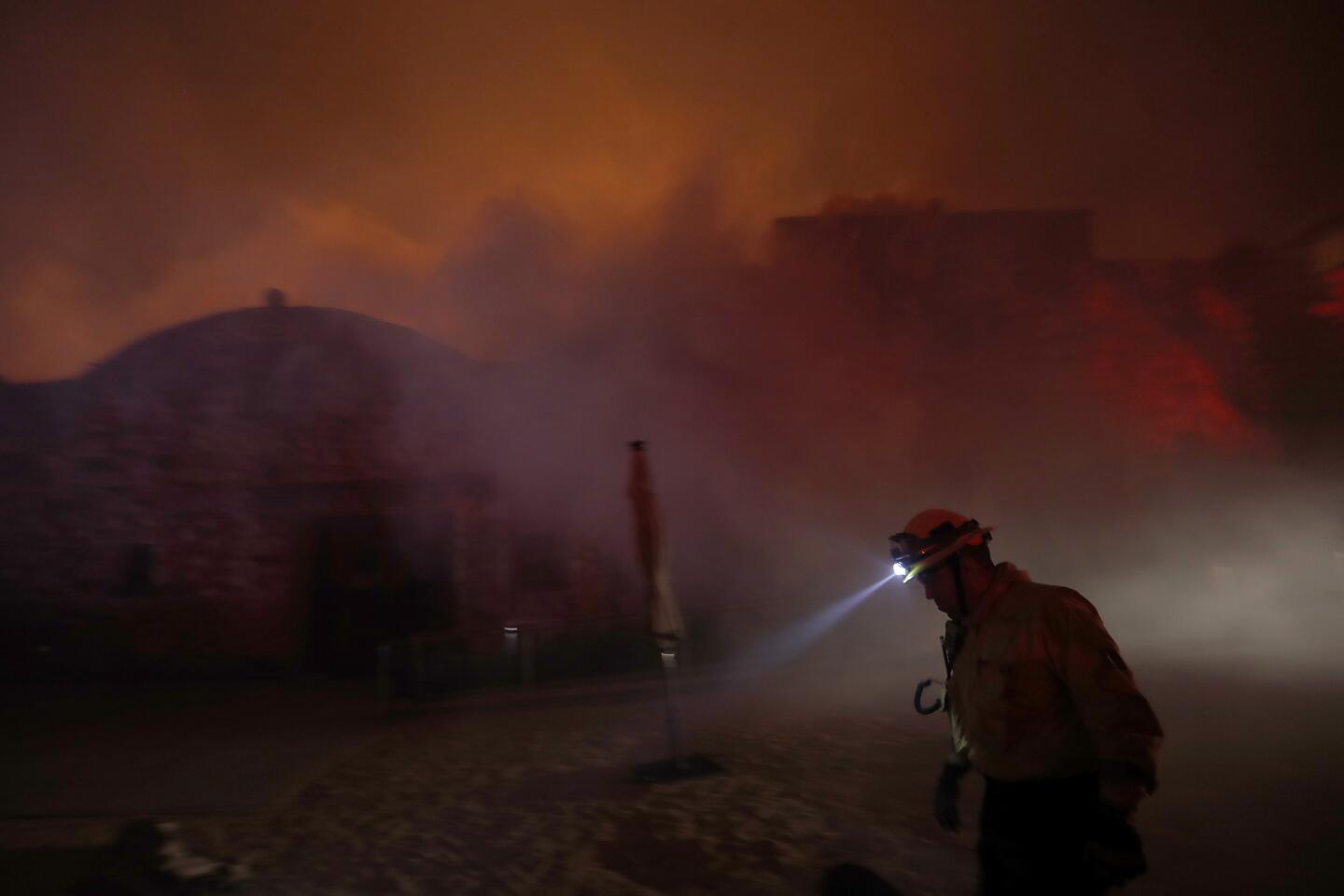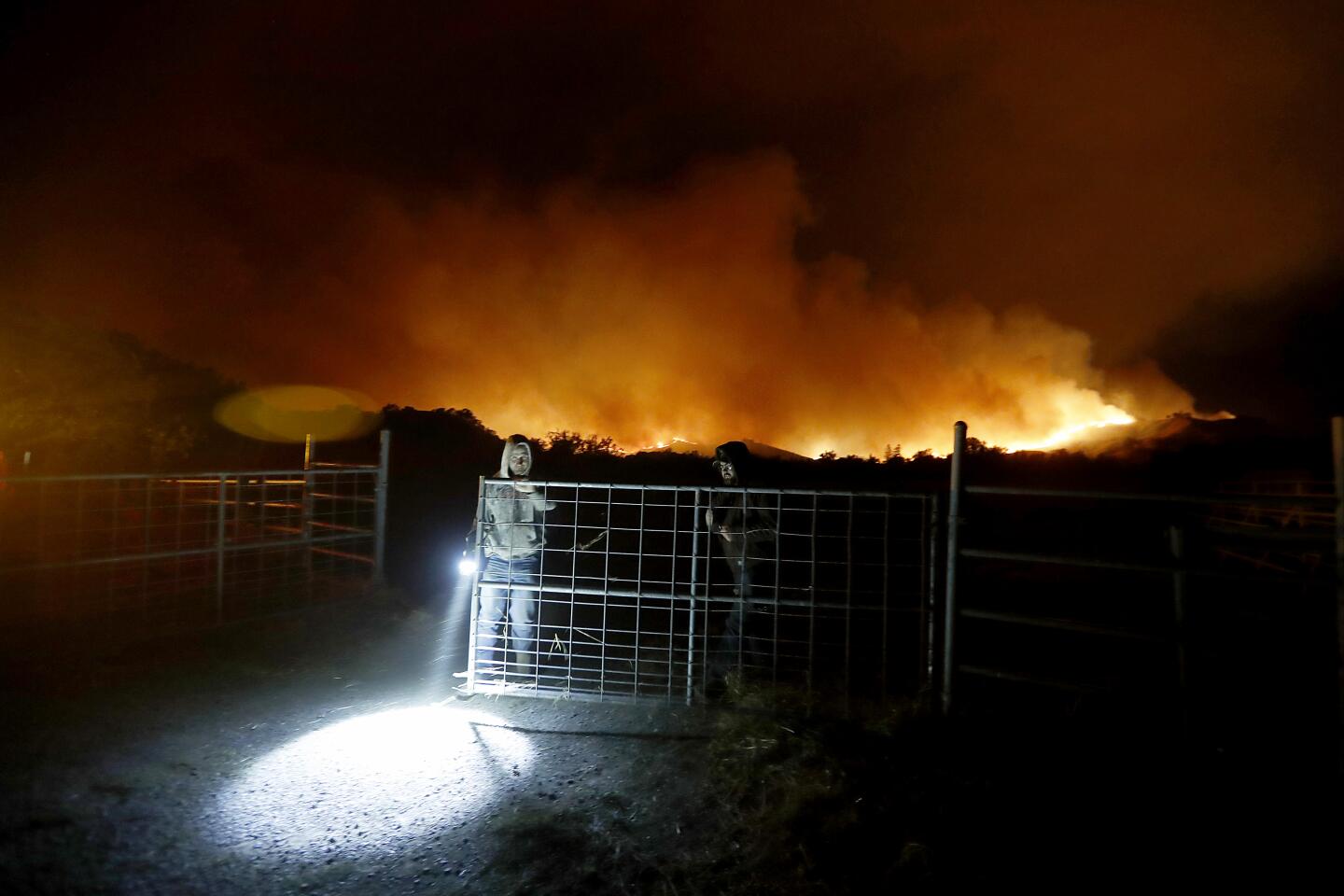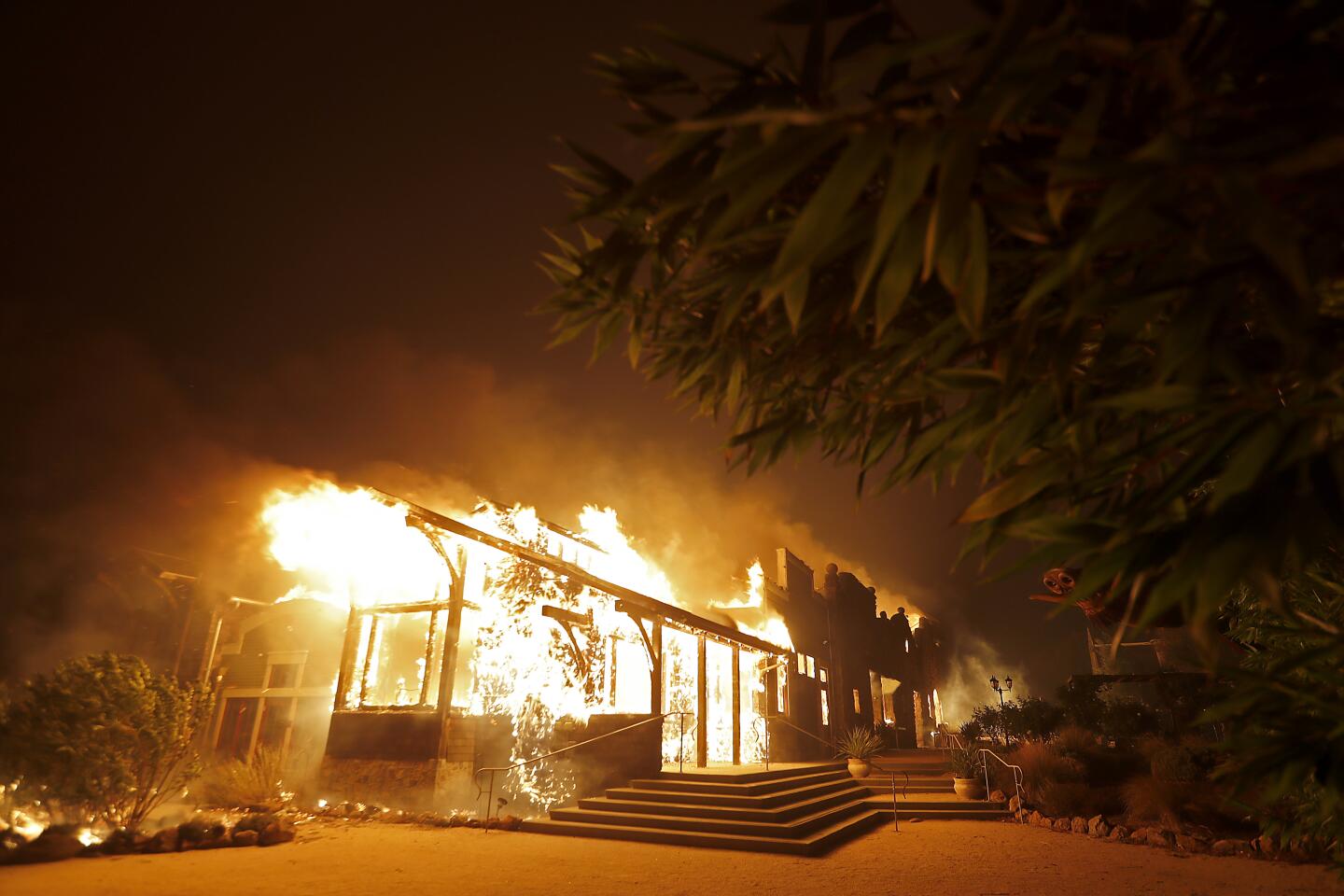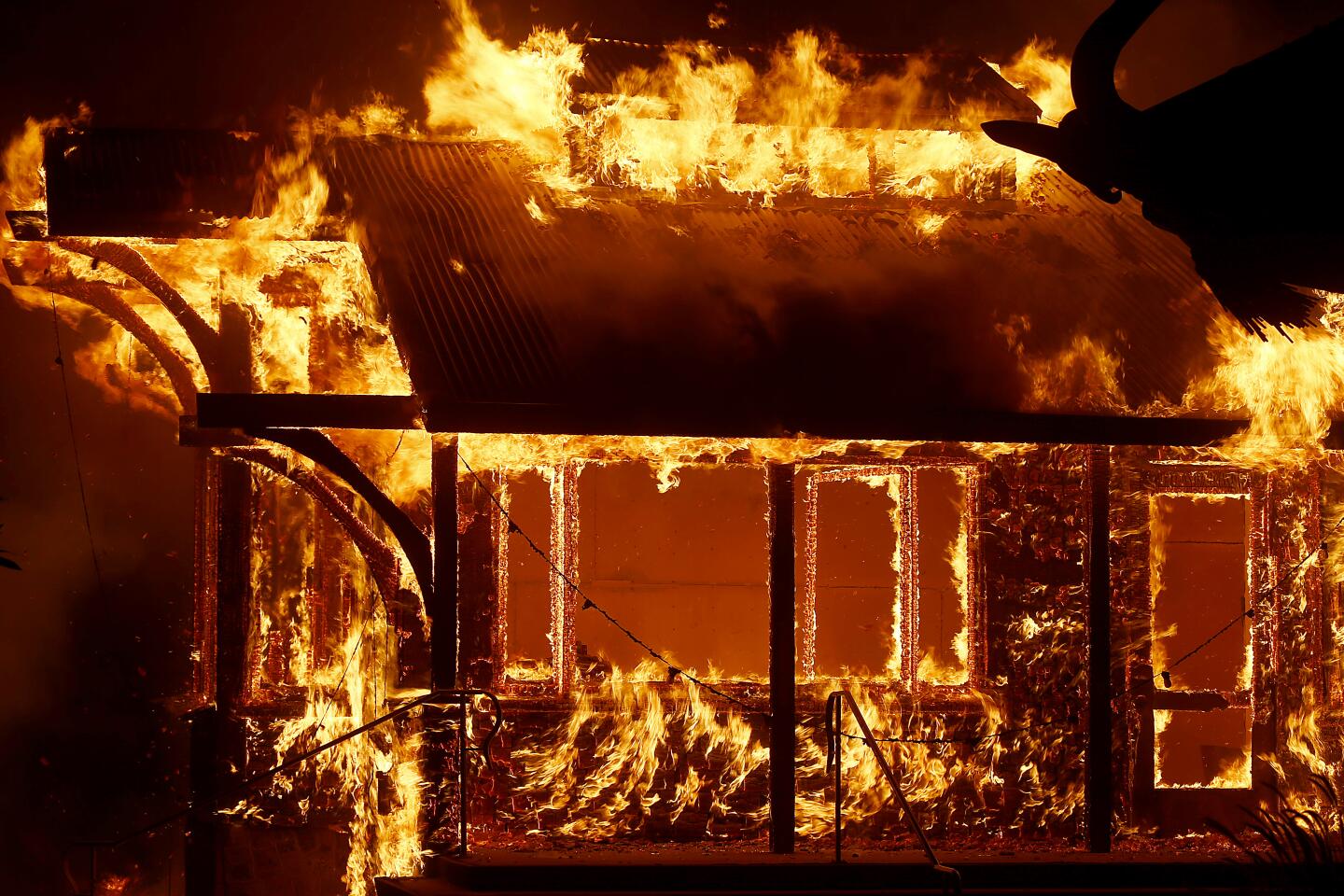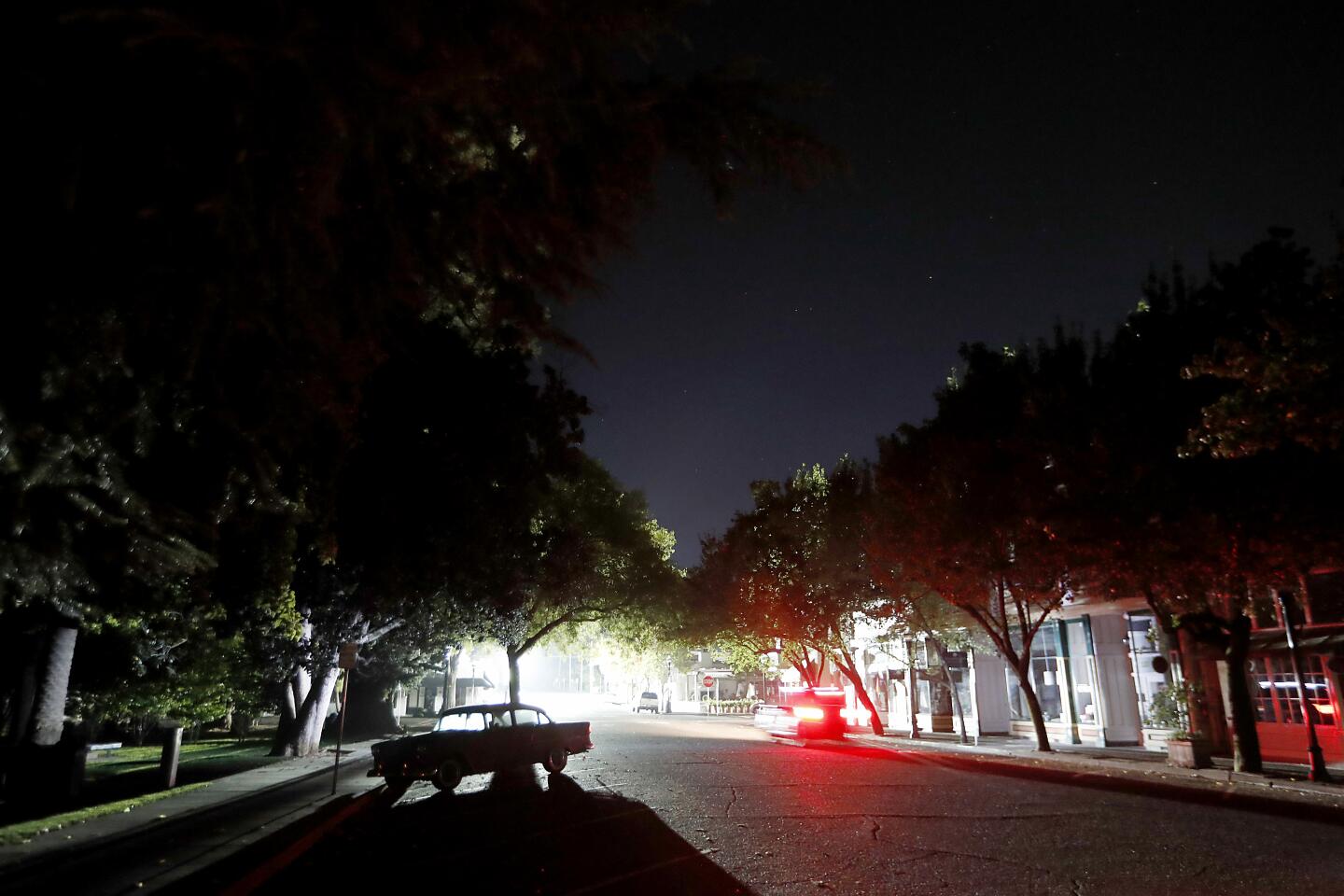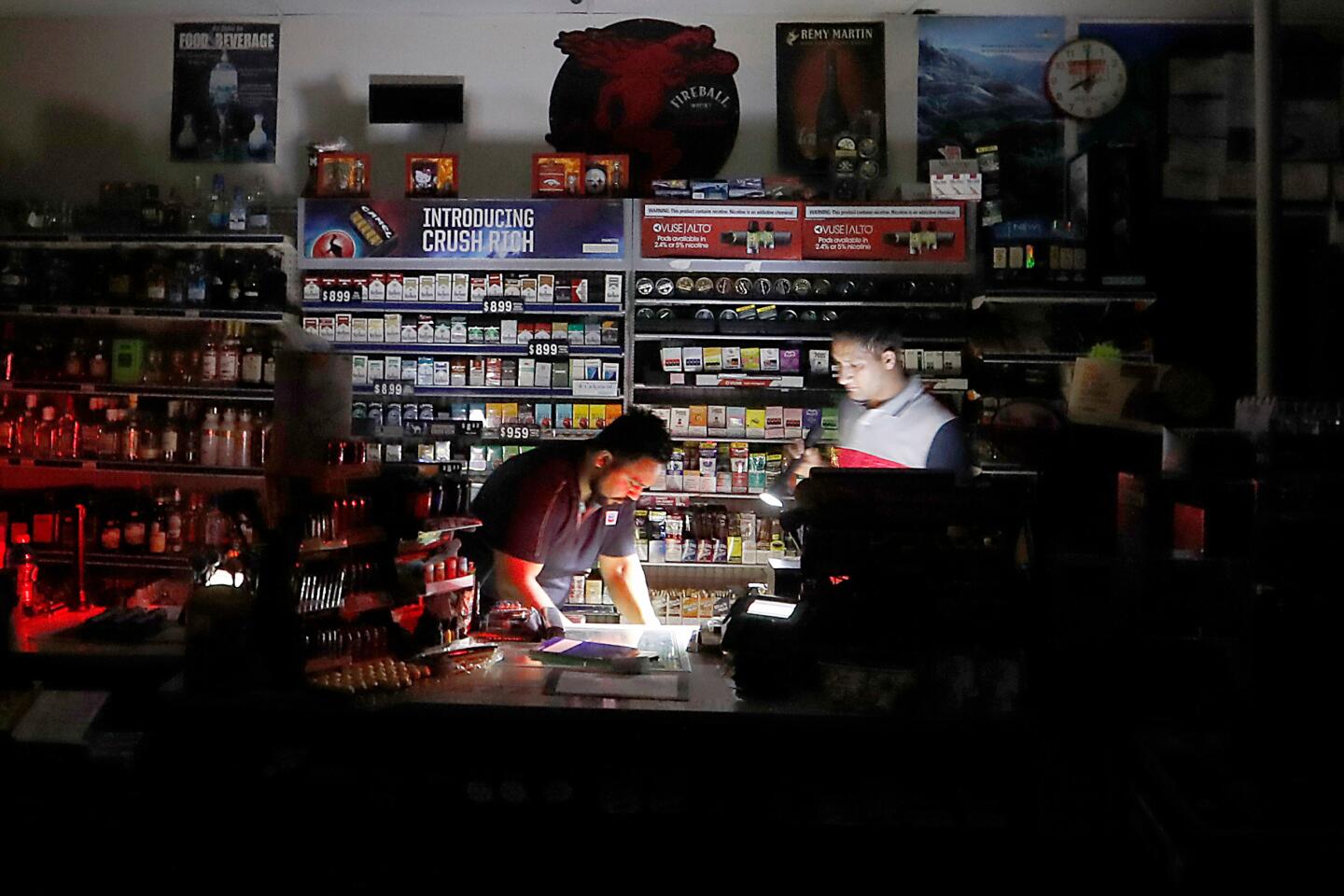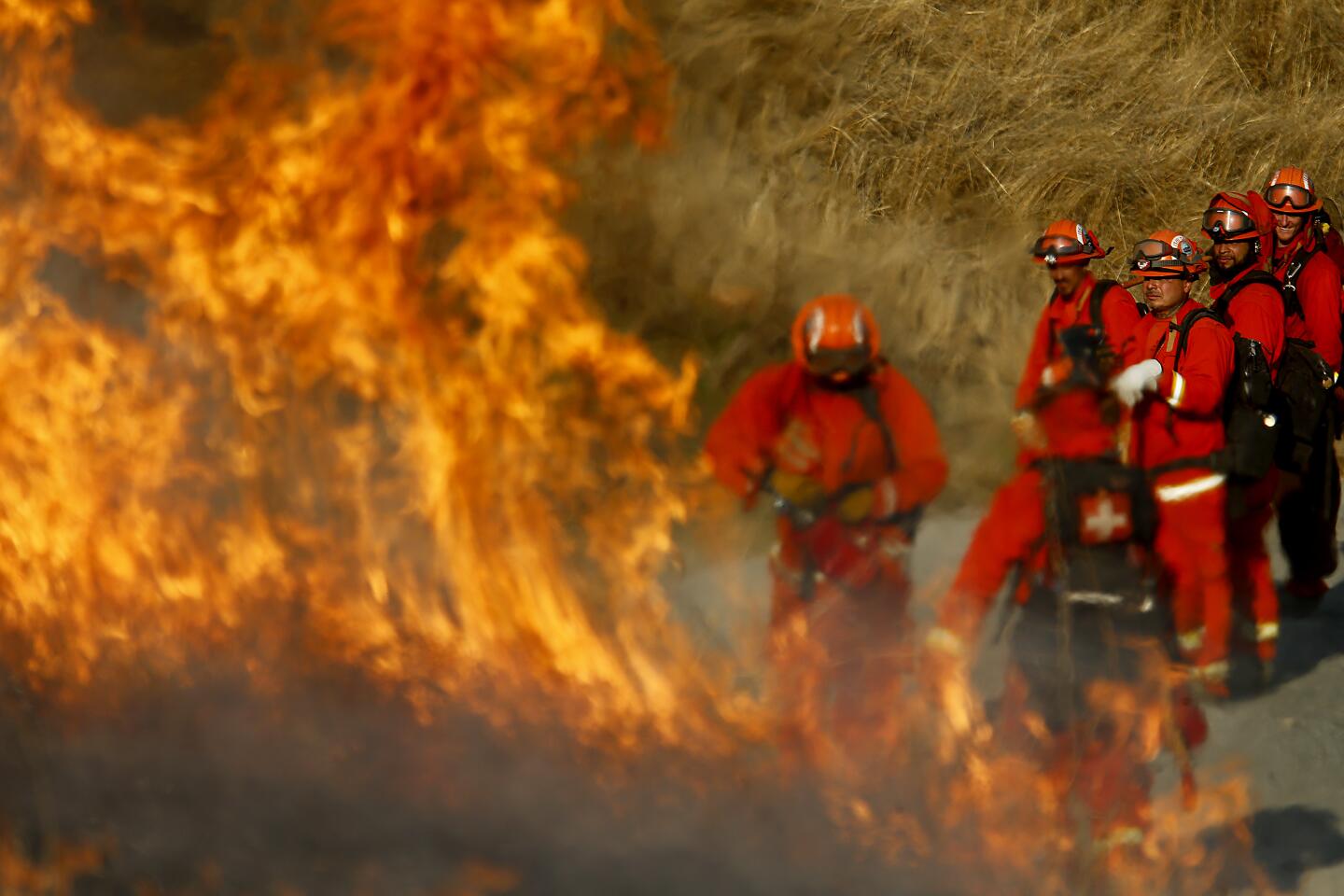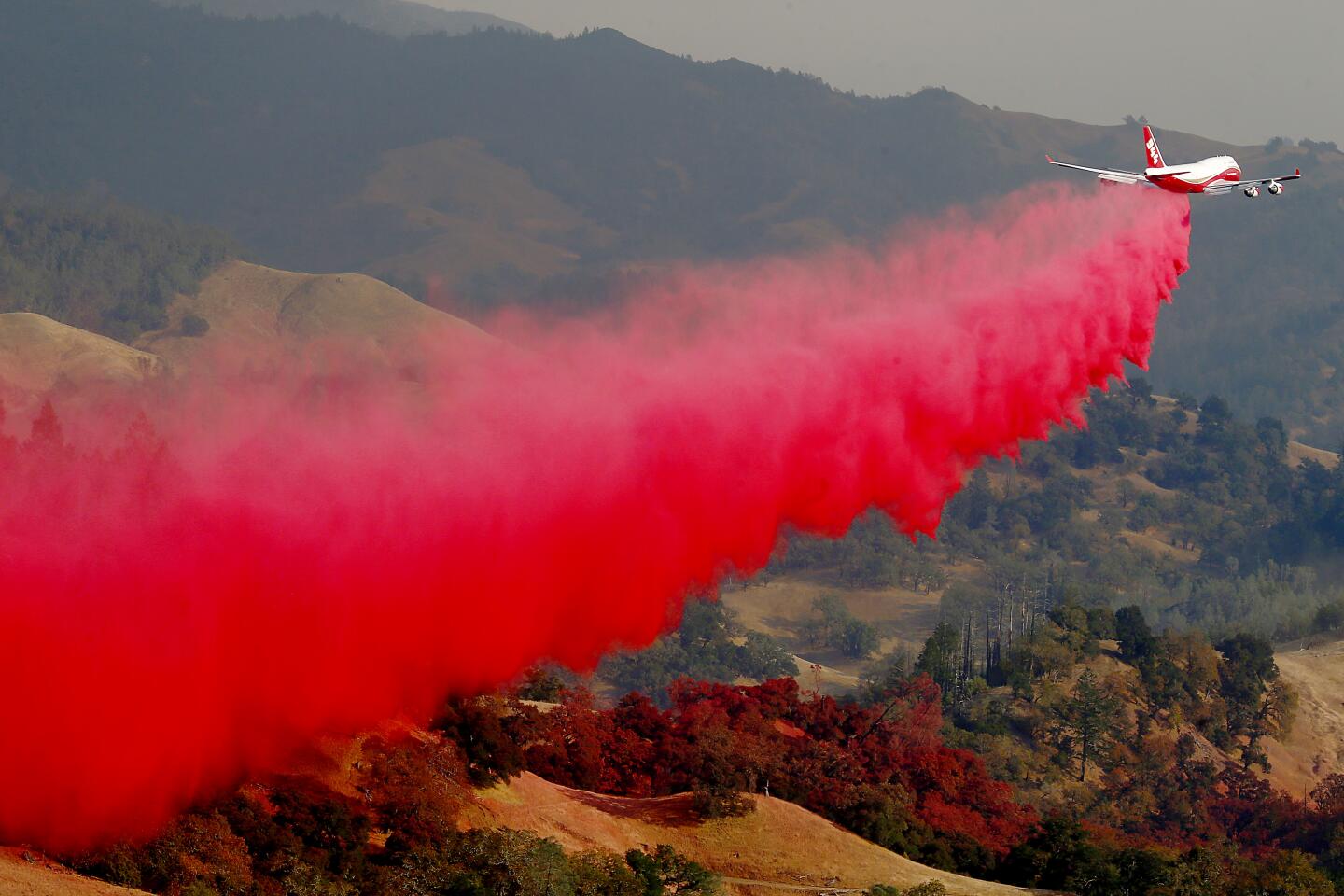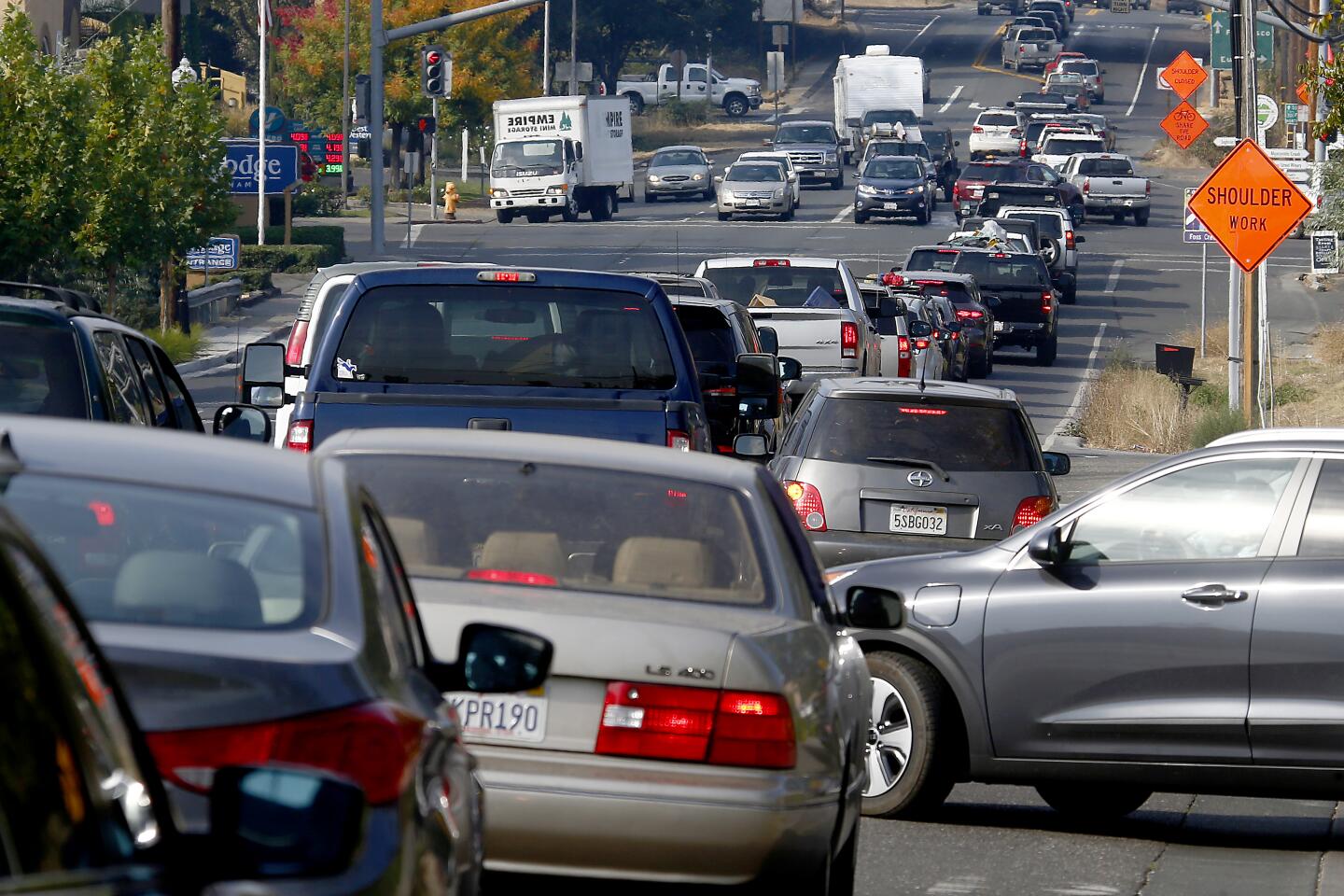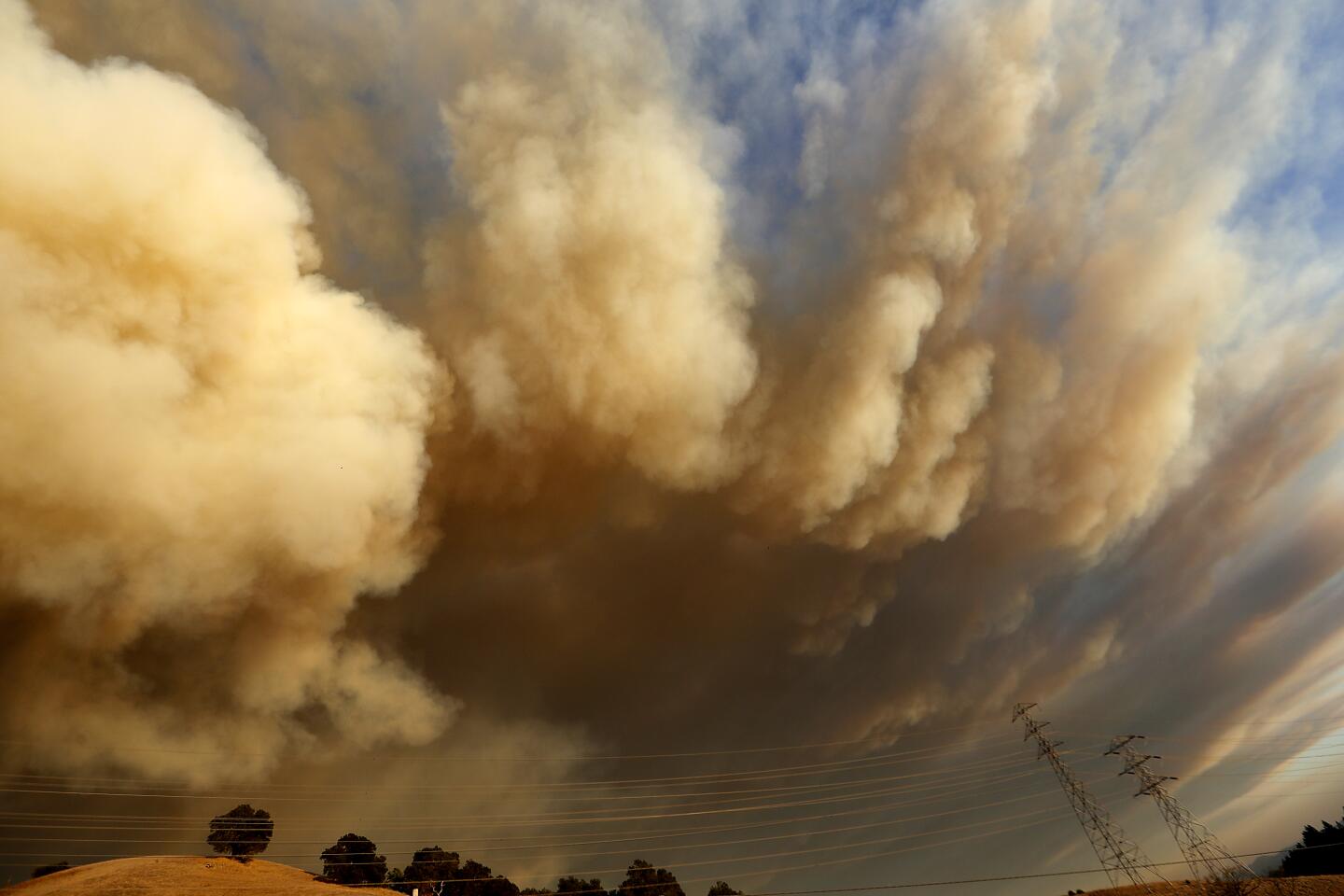Northern California fire and power crisis could last for days as powerful winds persist
- Share via
SANTA ROSA, Calif. — Fires exploded throughout Northern California on Sunday, driven by epic winds that snapped trees and pushed the state’s largest utility to shut power to more than 2 million people while tens of thousands evacuated the advancing flames in the dark.
From the San Francisco Bay to Clearlake, in the hills north of the Napa Valley, fire crews scrambled to beat down new blazes before they burst out of control, while they fought to head off the giant 5-day-old Kincade fire as it raced south, threatening Windsor and Santa Rosa.
Santa Rosa residents evacuated in the eerie black of Sunday morning, using flashlights and cellphones to light the way, many still recovering from the Tubbs fire, which devastated parts of the city and killed 22 people two years ago this month.
Pacific Gas & Electric Co. made the unprecedented decision to black out 940,000 residences and businesses, from Bakersfield to Eureka, in an effort to prevent its electric lines from sparking new fires in hurricane-force gusts.
The utility said it could take until Wednesday to inspect the affected lines — by foot, helicopter and drone — and restore power to its customers. At the same time, it warned that a new round of Diablo winds on Tuesday could prolong the blackouts and prompt new ones.
“Ensure you are prepared that your power may not come back,” between the end of the weekend’s power outage and the next one, said Andy Vesey, chief executive and president of PG&E.
Gov. Gavin Newsom declared a statewide emergency as he toured Sonoma County, where nearly 200,000 people had to evacuate. He visited three shelters in Petaluma, including one where three dozen patients from a skilled nursing facility specializing in dementia care were taken.
“To see them on cots in temporary shelter, it really hits home the human side of this and the enormity of the task of 180,000 people being evacuated,” Newsom said in an interview with The Times. “The issue of these winds remains the wild card, but the good news is we believe we have passed peak and by 11 [Monday] we should be in a very different wind condition.”
With wind gusts peaking at 96 mph in the Mayacamas Mountains on Sunday morning, and humidity dropping to a bone-dry 9%, the Kincade fire doubled in size in 24 hours to 54,298 acres and destroyed 94 structures, including the historic, stone-walled Soda Rock winery. By Sunday night, it was only 5% contained.
But firefighters had kept the flames out of populated areas, making a stand in the northeast corner of Windsor where the fire was pushing up to dense neighborhoods. No deaths were reported.
The fire’s massive mandatory evacuation footprint stretched across Sonoma and Napa counties, from the vineyards of the Alexander Valley to the coastal community of Bodega Bay, encompassing cities including Calistoga, Sebastopol, Healdsburg, Windsor and Santa Rosa.
Fire crews were working mainly on two fronts: trying to prevent the fire from jumping west over Highway 101 into a part of densely forested Coast Range that hasn’t burned since the 1940s, and from moving south into the subdivisions that have sprawled across the rural valley in recent decades.
In Santa Rosa, Honora Clemens, 93, was up monitoring the fire on television Sunday when she saw lights cut out at a block of nearby homes. The smoke was heavy but she didn’t see any embers, as she did when she fled the Tubbs fire. So far, they hadn’t been ordered to leave.
Then her television screen froze. Suddenly she felt cut off, and panicked. How would they know if they were ordered to evacuate?
She and her daughter packed up and left, driving to the fairgrounds, where they knew the routine: They spent 10 smoky days there in 2017.
Soda Rock is the original site of the Alexander Valley general store and post office, and was once the central hub of activity for the valley, the winery said on its website. The current owners were in the process of a painstaking restoration of the historic parts of the property.
As the wind moved south through the night, three fires broke out early Sunday morning in eastern Contra Costa County — two in Oakley along the San Joaquin River Delta and one in a small, rural neighborhood of Clayton in the mountainous area east of Mt. Diablo. “Miraculously, over the string of fires ... only one structure was damaged,” said Steve Hill, spokesman for the Contra Costa County Fire Protection District.
In mid-morning, a fire erupted in Vallejo and sent embers across the Carquinez Strait to light a new blaze in Contra Costa County, in the hills around Crockett.
The Lam family, of Fairfield, was just about to cross the Carquinez Bridge leaving Vallejo when their car was engulfed with smoke, with flames in the trees next to the road. Debris was raining down on the pavement.
At the wheel, Rebecca Lam couldn’t see but mere feet in front of her. Were there flames ahead? She didn’t know what to do. She pulled onto the center median and stopped. She considered turning around.
“What are you doing?” her husband asked.
She saw cars on the opposite side of the road — apparently seeing what was ahead of them and turning around, in her direction. She laid on the gas.
Their 2-year-old son yelled out from his car seat: “Hot. Hot.”
“Everything’s on fire,” her 5-year-old daughter said.
Lam tried to put a positive spin on it.
“Everything is going to be OK,” she said. “This is a once-in-a-lifetime experience and hopefully you’ll never experience it again, I hope.”
Nancy Jordan posted a video on Twitter as her husband drove on the bridge, just before authorities closed it. Trees along the side of the road can be seen bursting into flames just feet away from their vehicle.
“Whoa, you can feel it,” Jordan’s husband is heard telling his wife.
“Oh my God,” Jordan said. “I can’t believe they are letting us drive through this.”
By afternoon, fire had broken out in other parts of the county, in Martinez on the strait and, more perilously to residents, in the heavily wooded hills between Walnut Creek and Oakland.
In Lafayette, a police officer told the San Francisco Chronicle that the fire started near a power pole that fell and pulled down live wires. He said PG&E had not turned off power to that part of town.
In the neighboring town of Orinda, a firefighter knocked on doors about 2:30 p.m., telling residents to prepare to evacuate.
“Houses can be replaced,” the firefighter said. “People can’t.”
The wind howled. A large redwood tree had crashed into a resident’s yard. Downed branches littered city streets and Highway 24. Funnels of leaves swirled in the air.
Firefighters from the Tick fire in Santa Clarita were transferred north as conditions in Southern California calmed. More than 3,000 state, local and federal personnel were assigned to the Kincade fire alone. Sirens wailed constantly from Geyserville, the first community to get hit Thursday morning, to Santa Rosa.
Eddie Gravier was waiting on the side of the road in the predawn hours in his silver tanker truck. An employee of Redwood Coast Fuels, Gravier had been in the town all night refueling firetrucks and emergency vehicles as they battled in the hills just a short distance away.
“By 4 o’clock, the spot fires started up again and they said, ‘Get out of here,’” Gravier said. “I said, no problem.”
By sunrise, in the Coffey Park neighborhood of Santa Rosa, Karen Kristensen was packing up the home she and her 88-year-old mother had just moved into in August, after the last one burned to the ground in 2017. Many of the homes on her block were brand new or still under construction.
Last time, they escaped with just some laundry and a few pictures. “I wore shorts for two weeks,” she said. “Everything was dust. There was nothing left.”
They were more prepared this round, given plenty of warning.
“This stupid thing has been ringing all night,” she said, holding up her cellphone. “Which is good. I have no problem with it.”
Nearby Daniel Barcenas, his two brothers and his 80-year-old grandmother were still in their house before dawn on Sunday. Barcenas had lost two homes in the last fire. He lived in Coffey Park in a rental with his grandma and had just purchased a nearby home.
“The day before the fire we had just finished painting,” he said. Now it is just a vacant lot, and he has purchased this third home that once again faces the danger of destruction.
The night of the Tubbs fire, the smoke was so bad that he could not see in front of him and traffic was at a standstill in the subdivision. The only light was from explosions. At one point, he feared he would have to get out of the car and carry his grandmother to safety.
This time, he says he is staying behind because his brother, Eduardo, refuses to leave.
“He’s stubborn,“ Barcenas said. Eduardo had spent the day watering down the lawn but Barcenas was not convinced they were safe, given his last experience.
“It’s like what it must have been like to survive the Titanic and have to go through it all again,“ he said.
Times staff writers Rong-Gong Lin II in San Francisco, John Myers in Sacramento and Dakota Smith, Cindy Carcamo, Ralph Vartabedian and Laura Newberry in Los Angeles contributed to this report.
More to Read
Sign up for Essential California
The most important California stories and recommendations in your inbox every morning.
You may occasionally receive promotional content from the Los Angeles Times.
